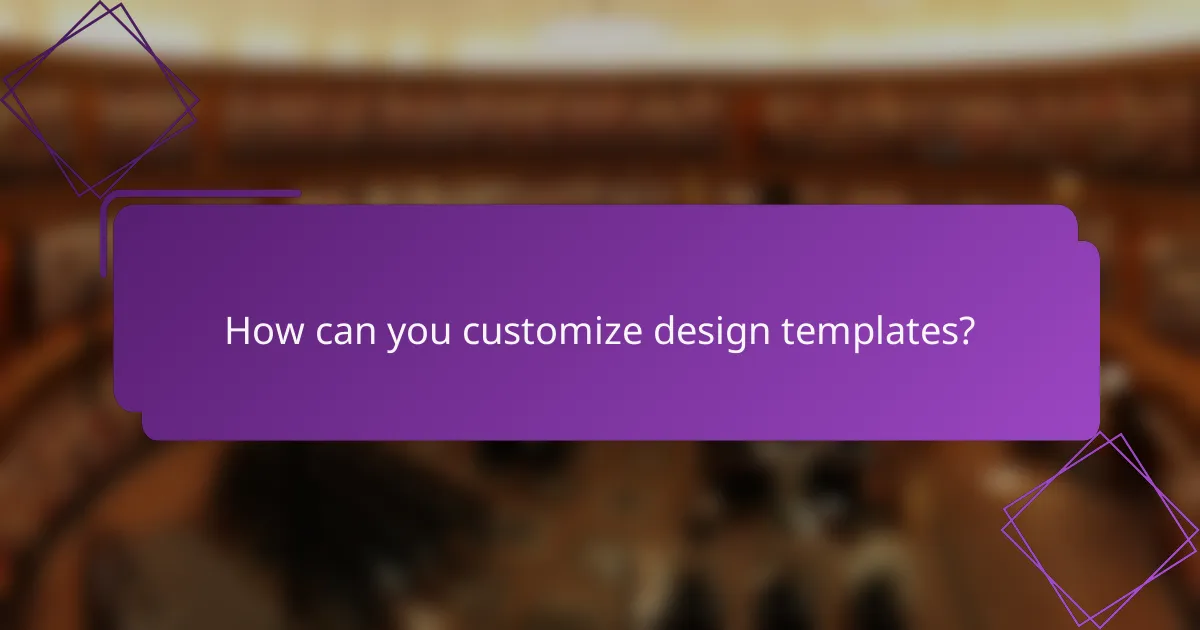Design templates provide a practical solution for creating professional materials efficiently, offering benefits such as cost savings and consistency. By customizing these templates, users can tailor elements to fit their branding and enhance the overall appeal of their projects. A variety of platforms offer quality design templates, catering to diverse needs and budgets, making it easy to find the right fit for any project.

What are the benefits of using design templates?
Design templates offer numerous advantages, including efficiency, cost savings, and consistency. They enable users to create visually appealing materials quickly while maintaining a professional look.
Time-saving efficiency
Using design templates significantly reduces the time spent on creating materials from scratch. Templates provide a ready-made structure, allowing users to focus on content rather than layout. This can lead to completion times that are cut in half compared to traditional design methods.
For instance, a marketing team can produce promotional materials in a matter of hours instead of days, enabling faster campaign launches and responses to market changes.
Cost-effectiveness
Design templates can be a cost-effective solution for businesses, especially small enterprises. By utilizing templates, companies can reduce the need for hiring professional designers for every project, saving on labor costs. Many templates are available for free or at a low cost, making them accessible to various budgets.
Investing in a quality template can yield long-term savings, as it can be reused across multiple projects, further maximizing the initial expenditure.
Consistency in branding
Design templates help maintain brand consistency across different materials. By using the same templates, businesses ensure that their logos, colors, and fonts remain uniform, reinforcing brand identity. This consistency is crucial for building recognition and trust with customers.
For example, a company can use the same template for social media posts, brochures, and presentations, creating a cohesive look that strengthens their brand image.
Professional appearance
Templates are designed by professionals, which means they often adhere to best practices in design. This results in a polished and professional appearance that can enhance the credibility of the materials. A well-designed template can elevate the quality of presentations, reports, and marketing collateral.
Using a professional template can make a significant difference in how a business is perceived, especially in competitive markets where first impressions matter.
Ease of use for non-designers
Design templates are user-friendly, making them accessible to individuals without a design background. Most templates come with intuitive interfaces that allow users to easily customize elements such as text, images, and colors. This democratizes design, enabling anyone to create attractive materials without extensive training.
For example, a small business owner can quickly edit a template for a flyer using basic software, empowering them to manage their marketing efforts independently.

How can you customize design templates?
Customizing design templates involves altering various elements to align with your specific needs and branding. This process can enhance the visual appeal and functionality of your project, making it more relevant to your audience.
Adjusting colors and fonts
Changing colors and fonts is a fundamental step in customizing design templates. Select a color palette that reflects your brand identity, ensuring that it resonates with your target audience. For fonts, choose styles that enhance readability while maintaining a professional appearance.
Consider using tools like Adobe Color or Coolors to create harmonious color schemes. When selecting fonts, aim for a combination of a primary font for headings and a complementary one for body text to create visual interest.
Incorporating brand logos
Adding your brand logo to a design template is essential for establishing brand recognition. Place the logo in prominent locations, such as the header or footer, to ensure visibility without overwhelming the design.
Ensure that the logo is high-resolution and fits well within the overall layout. You may need to adjust the size or placement to maintain balance and harmony with other design elements.
Modifying layouts and structures
Customizing layouts and structures allows you to tailor the template to better suit your content and audience. This can involve rearranging sections, changing grid layouts, or adjusting spacing to enhance usability and visual flow.
When modifying layouts, keep user experience in mind. Ensure that navigation is intuitive and that important information is easily accessible. Tools like Figma or Sketch can help visualize these changes effectively.
Adding custom images and graphics
Incorporating custom images and graphics can significantly enhance the appeal of your design template. Use high-quality images that align with your content and brand message, ensuring they are relevant and engaging.
Consider using stock photo websites or creating your own graphics to maintain originality. Be mindful of image sizes to optimize loading times, as large files can slow down your site, negatively impacting user experience.

Where to find quality design templates?
Quality design templates can be found across various platforms that cater to different needs and budgets. Whether you are looking for free options or premium designs, there are several reliable sources to explore.
Canva for versatile options
Canva offers a wide range of design templates suitable for various projects, from social media graphics to presentations. Its user-friendly interface allows for easy customization, making it accessible for both beginners and experienced designers.
With thousands of templates available, users can quickly find designs that fit their specific needs. Canva also provides a free tier, but premium templates and features are available through a subscription.
Adobe Stock for premium designs
Adobe Stock is known for its high-quality, premium design templates that cater to professional needs. Users can access a vast library of templates created by top designers, ensuring a polished and sophisticated look for any project.
While Adobe Stock operates on a credit system, users can purchase individual templates or opt for a subscription for more cost-effective access. This platform is ideal for those who prioritize quality and are willing to invest in their designs.
Envato Elements for subscription access
Envato Elements provides a subscription model that grants unlimited access to a diverse collection of design templates. This platform is particularly beneficial for freelancers and agencies that require a steady stream of fresh designs.
With thousands of templates available across various categories, users can easily find what they need. The subscription covers not just templates but also stock photos and audio, making it a comprehensive resource for creative projects.
Creative Market for unique styles
Creative Market is a marketplace for independent designers to sell their unique templates. This platform is ideal for those seeking distinctive styles that stand out from mainstream options.
Users can purchase individual templates, often with a one-time fee, and the variety includes everything from business cards to website themes. This approach allows for a more personalized touch in design projects, catering to specific brand aesthetics.

What criteria should you consider when choosing design templates?
When selecting design templates, consider factors such as alignment with your target audience, adaptability to different projects, and compatibility with your design software. These criteria ensure that the templates meet your specific needs and enhance your overall design process.
Target audience alignment
Understanding your target audience is crucial when choosing design templates. The template should resonate with the preferences and expectations of your audience, whether they are consumers, clients, or stakeholders. For example, a playful template may work well for a children’s product, while a sleek, professional design is better suited for corporate presentations.
To assess alignment, consider conducting surveys or focus groups to gather insights about your audience’s tastes. This feedback can guide your selection, helping you choose templates that effectively communicate your message and engage your viewers.
Template adaptability
Template adaptability refers to how easily a design can be modified for various purposes. A versatile template should allow for changes in layout, color schemes, and content without losing its visual appeal. This flexibility is essential for businesses that may need to repurpose designs for different campaigns or platforms.
When evaluating adaptability, look for templates that offer multiple layout options or customizable elements. This way, you can tailor the design to fit specific needs, whether it’s for social media, print, or web use, ensuring consistency across all channels.
Design software compatibility
Compatibility with your design software is a key factor in choosing templates. Ensure that the templates you consider are compatible with popular design tools like Adobe Creative Suite, Canva, or Sketch. This compatibility will streamline your workflow and reduce the time spent on adjustments or conversions.
Before purchasing or downloading a template, check the file formats provided and any software requirements. Templates that are specifically designed for your chosen software will save you from potential headaches and allow for a smoother design experience.

How do design templates compare across platforms?
Design templates vary significantly across platforms in terms of customization options, usability, and compatibility. Each platform offers unique features that cater to different user needs, making it essential to evaluate them based on your specific requirements.
Customization Options
Customization options for design templates can differ widely between platforms. Some platforms, like WordPress, provide extensive flexibility with plugins and custom code, allowing users to tailor templates to their needs. In contrast, simpler platforms like Canva may offer limited customization but excel in user-friendliness and quick edits.
When choosing a platform, consider how much customization you require. If you need a highly personalized design, opt for platforms that support advanced editing. For quick, straightforward projects, a more limited platform may suffice.
Usability and Learning Curve
Usability is a critical factor when comparing design templates across platforms. Some platforms are designed for beginners, featuring drag-and-drop interfaces, while others may require a steeper learning curve due to their advanced features. For instance, Adobe XD offers powerful tools but can be overwhelming for new users.
Evaluate your comfort level with technology and choose a platform that matches your skills. If you’re new to design, look for platforms with tutorials and community support to help you get started.
Compatibility and Integration
Compatibility and integration capabilities are essential when selecting design templates. Some platforms seamlessly integrate with other tools, such as social media or e-commerce sites, enhancing your workflow. For example, Shopify templates are optimized for online stores, making it easy to manage products and sales.
Before committing to a platform, check its compatibility with the tools you already use. This can save time and streamline your design process, ensuring that your templates work well across different applications.

